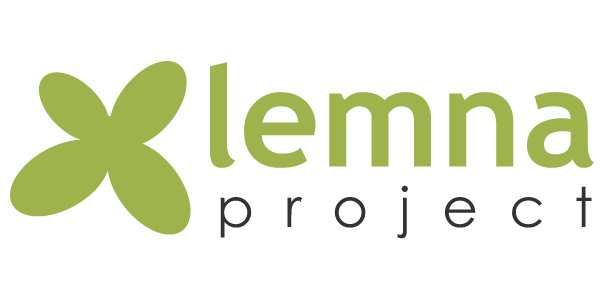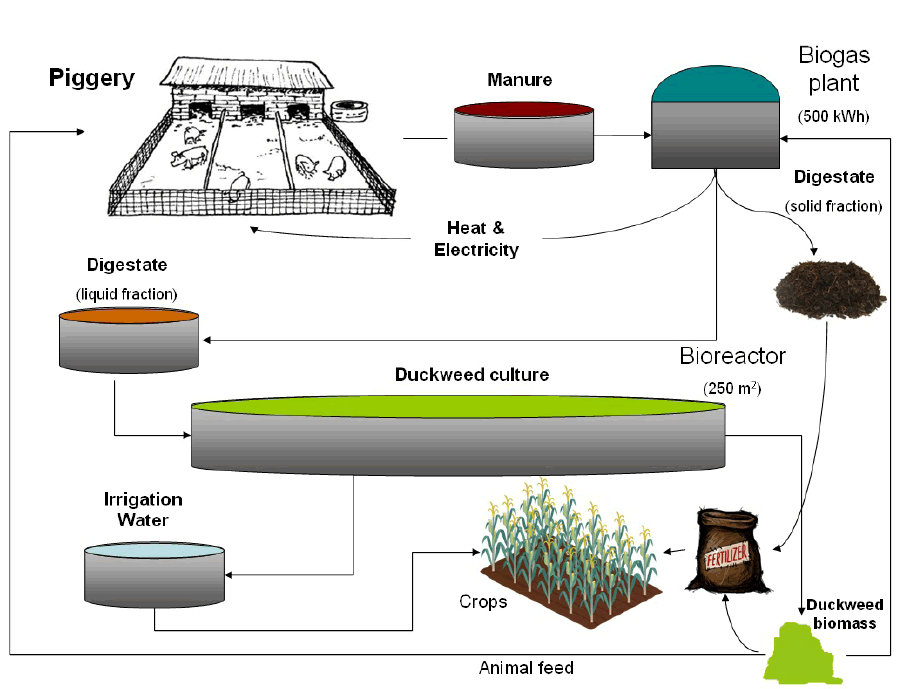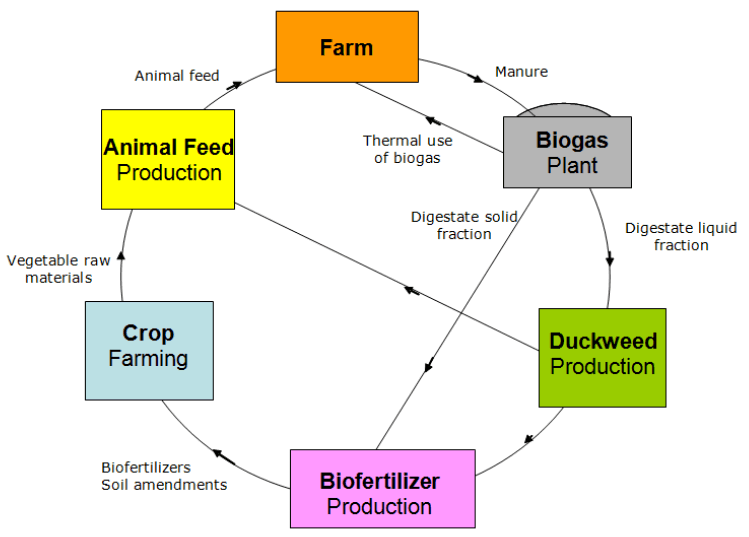

LIFE LEMNA aims to construct the first full scale nutrient removal system in EU based on the production of duckweed which will be applied to uptake N, P and other nutrients from the swine manure after an anaerobic digestion. The resulting duckweed biomass will be a source of high value protein source for feed (bio-based products) and biofertilizers.
Duckweed is a small floating macrophyte that has a high capacity for removing dissolved nutrients from water, especially nitrogen and phosphorous compounds, as well as for reducing organic matter and suspended solids. However, the great advantage of this plant group over other macrophytes used in effluent treatment is the production of a biomass with high nutritional value.
LIFE LEMNA aims to demonstrate the first full scale in EU innovative system for nutrient recovery from swine manure based on the combined AD and duckweed systems. A previous anaerobic digestion treatment of the swine manure promotes the mineralization of the organic N and P, thus increasing the bioavailability and overall nutrient uptake efficiency of the duckweed.
Industrial scale duckweed systems could perform approximately 65.7 t biomass DW/ha•year as average and a 40% of protein content. Considering this average data, an excess of 1 kg of N/d in the digestate stream could be uptaken by a 0.08 ha duckweed system producing 6 kg of pure protein. Hence, assuming a price of 800 €/t of pure protein (current market price for soya protein), the incomes would rise 4.8 €/kg of recovered N.
The hypothesis proposed by LIFE LEMNA will be evaluated from the technical, environmental and economical point of view in a 250 m2 bioreactor installed at the facilities of Exporinsa, a representative pig farm located in Osa de la Vega (Cuenca, Spain). Exporinsa treats the manure of 73,000 piglets/a within a anaerobic digestion plant of 500 kW with a treatment capacity of 36,500 m3/y.

A 250 m2 duckweed-based bioreactor could represent the 25% of an full scale unit module of a duckweed-based system to treat the total volume of the digestate produced in the farm. Duckweed reactor could treat daily 3.3 m3 of digestate and will produce 34.7 kg of DW biomass. Prototype design will be based on existing designs type raceway but including a novel culture recirculation system therefore optimizing the nutrient uptake by the duckweed. The dimensions of the raceway will be based on parameters such as the available area, effluent flow and the hydraulic retention time (HRT). Environmental parameters as solar radiation and ambient temperature as well as culture conditions inside reactors such as pH, temperature, mixing and dissolved oxygen will be on-line measured by means of an adapted control system. In addition, an integral automated system of pumps and valves will be implemented in order to add swine slurry ensuring the correct nutrient concentration for the optimal duckweed growth and therefore improve the nutrient removal. Additionally, a cover will be installed to both prevent from birds and low ambient temperature during the winter time.
Besides, a covered little pond will be installed near the culture pond as a duckweed stock and to avoid lag phase in duckweed growth due to previous acclimatization. The harvesting will be carried out with a skimming system, maintaining the crop at a desirable density and keeping certain coverage of the pond surface by the duckweed averting algal growth.
LIFE LEMNA will also exploit the natural diversity present among strains duckweed species for optimize the extraction of nutrients and production of duckweed biomass. To this end, LIFE LEMNA will develop the first duckweed strain collection from the Iberian Peninsula, including multiple species from a broad range of climatic areas. Moreover, last generation of molecular biology techniques will be used to efficiently exploit the natural diversity of duckweed species. This information will be the basis for the e-LEMNAtool for making a first economical and technical assessment of LEMNA system for a different climate conditions. The e-LEMNAtool will be a relevant resource to be used in the replication activities to be carried out after de project.
To sum up, LIFE LEMNA will demonstrate an innovative and more sustainable nutrient (nitrogen and phosphorous) uptake system for swine manure streams based on combining AD and duckweed technologies. As a result, a high value protein biomass will be produced to be used as both bio-fertiliser and animal feed. The system proposed by LIFE LEMNA is a clear example of circular economy, where excess of nutrients on manure causing environmental impacts becomes a resource for direct recycling as feedstock and organic fertilizers.


E-lemna tool is the first application to analyize the economical and technical assessment of LEMNA system for a different climate conditions, and it will be a relevant resource to be used in the replication activities to be carried out after de project.